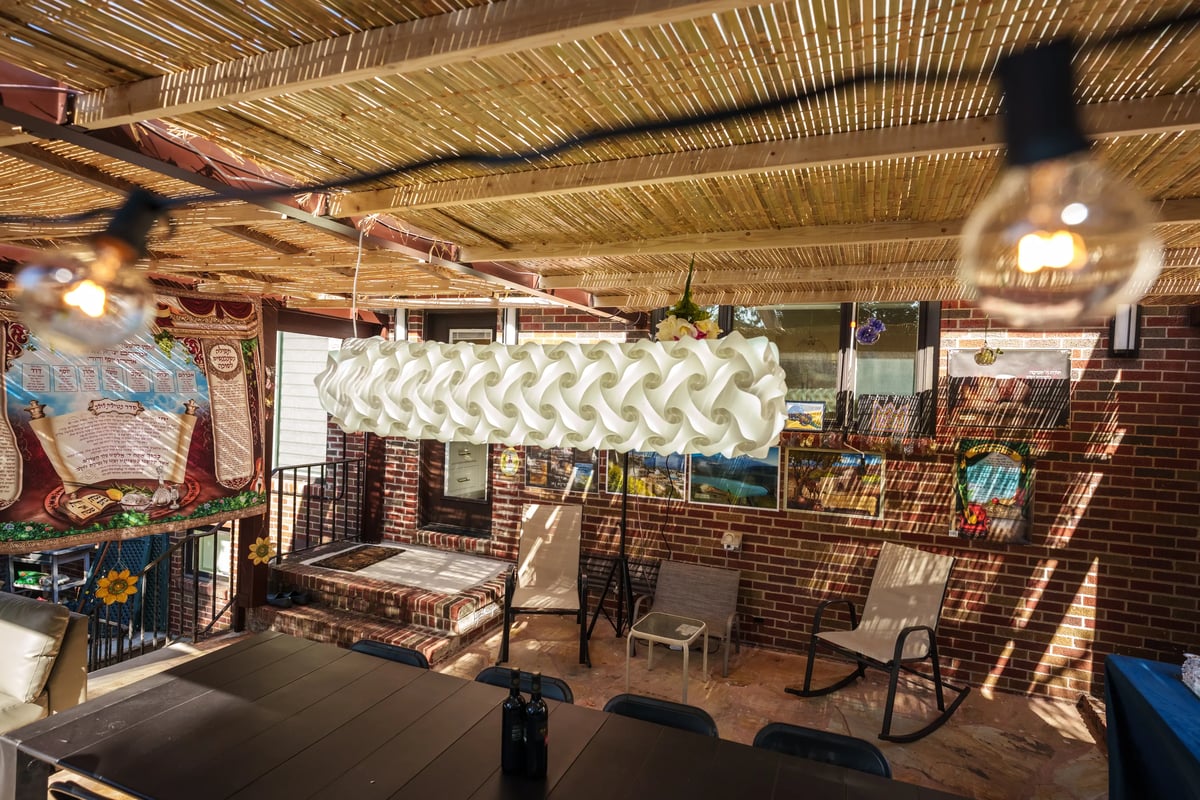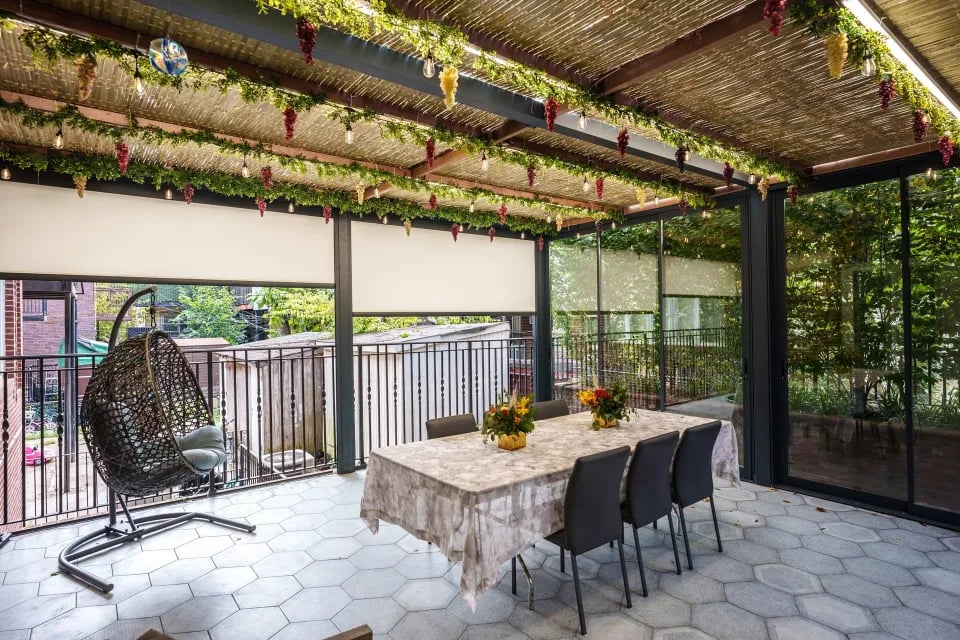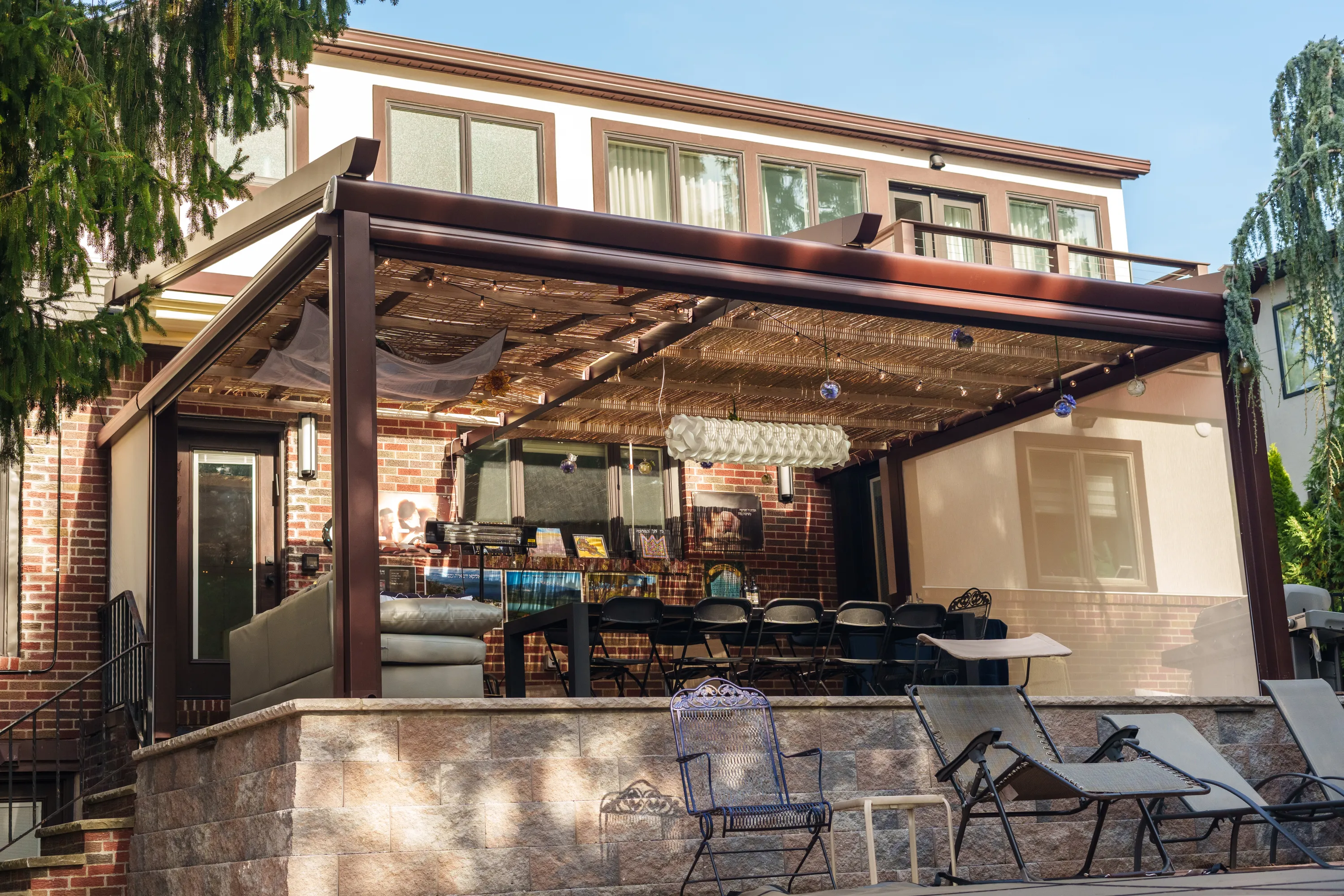Creating a Sukkah Oasis: How to Incorporate Your Pergola into Your Sukkah Design
Sukkot, also known as the Feast of Tabernacles, is a joyous Jewish festival that commemorates the 40-year journey of the Israelites through the desert after the Exodus from Egypt. It's a time of celebration, reflection, and unity, during which families and communities come together to observe various traditions. One of the central customs of Sukkot is the construction of a sukkah, a temporary hut or booth. The sukkah holds immense significance during this holiday. It serves as a symbol of the Israelites' humble dwellings in the wilderness and a reminder of the shelter and protection provided by the Divine. It's a place for gathering, prayer, and meals throughout the week-long festival. In this article, we will explore a creative approach to enhancing your Sukkot celebration. We'll delve into the concept of integrating a pergola into your sukkah design. By doing so, you can transform your sukkah into a unique and comfortable oasis, adding a modern twist to this ancient tradition. Join us on this journey as we discover how to combine the beauty of a pergola with the time-honored customs of Sukkot, creating a space where tradition and comfort coexist harmoniously.
What is Sukkot?
Sukkot, often referred to as the Feast of Tabernacles, is a cherished Jewish festival with deep historical and spiritual significance. This joyous holiday falls on the 15th day of the Hebrew month of Tishrei, typically in September or October, and lasts for seven days (eight days for those living outside of Israel). It marks a period of gratitude, reflection, and celebration.
The festival also coincides with the agricultural harvest season in Israel, making it a time of thanksgiving for the bountiful crops and the blessings of the earth. This connection to the land and its produce adds an agricultural dimension to the holiday's significance. At the heart of Sukkot is the sukkah itself. The sukkah is a temporary dwelling that harks back to the makeshift shelters used by the Israelites in the desert. Constructed with specific guidelines, including natural materials for the roof (schach) and walls (s'chach), the sukkah serves as a tangible representation of the transient nature of human existence and the reliance on divine protection.
How to Build a Sukkah?
Building a sukkah is a cherished tradition that requires careful attention to detail and adherence to specific guidelines. In this section, we'll explore the two main approaches: constructing a traditional sukkah and incorporating your existing pergola into the design.

Building the Traditional Sukkah
When building a traditional sukkah, it's essential to follow these basic requirements to ensure a kosher (ritually correct) structure:
- Dimensions: A sukkah should have at least three walls, with a preferred minimum height of ten handbreadths (approximately 30 inches). The walls should be sturdy but not permanent.
- Roof Covering (Schach): The roof covering, known as schach, must be made from natural materials like branches, leaves, or bamboo. These materials should provide enough shade during the day while allowing occupants to see the stars at night.
- Stability: Ensure that your sukkah is stable and secure. It should withstand reasonable weather conditions and be safe for you and your guests. Use appropriate materials for the walls, such as canvas, wood, or fabric, and secure them firmly.
- Decorations: Traditional decorations like fruit, garlands, and artwork are often hung inside the sukkah to enhance its beauty and festive atmosphere.
Incorporating Your Pergola
Now, let's consider the innovative approach of integrating your pergola into your sukkah design:
- Utilizing Existing Pergola: If you have a pergola in your garden or backyard, you're in luck. Pergolas, with their stable structures and overhead beams, provide an excellent foundation for a sukkah. The advantages of using your pergola include increased stability, shade, and a sturdy base.
- Schach Integration: To convert your pergola into a sukkah, you can place the required schach directly on top of the pergola's beams. Ensure that the schach covers the majority of the pergola's roof, creating adequate shade while fulfilling the schach requirement. Be mindful to leave some gaps in the schach for visibility of the stars.
- Safety and Compliance: While using a pergola is convenient, it's crucial to ensure that your sukkah still complies with the sukkah-building guidelines. Check the dimensions, stability, and roof covering to make sure they meet kosher standards.
By incorporating your pergola into your sukkah design, you can create a unique and comfortable sukkah that respects tradition while taking advantage of the stability and shade provided by your existing outdoor structure. This innovative approach adds a modern twist to this time-honored tradition, making it both meaningful and convenient.
What is Required for Sukkah?
To create a kosher sukkah, it's essential to understand the specific requirements that ensure adherence to Jewish tradition. In this section, we'll delve into the key elements of a kosher sukkah, focusing on the schach (roof covering) and walls, and emphasize the significance of adhering to these guidelines.
- Schach (Roof Covering)
The schach, or roof covering, is a fundamental component of a sukkah. It serves both a symbolic and practical purpose. Here are the requirements for schach:
- Natural Materials: The schach must consist of natural, plant-based materials such as branches, leaves, or bamboo. These materials connect the sukkah to the earth and evoke the idea of temporary shelter.
- Proper Placement: The schach should be placed on top of the sukkah structure, providing adequate shade during the day. However, it should be sparse enough to allow occupants to see the stars at night, reminding them of the divine protection that guided the Israelites in the desert.
- Stability: While the schach should be loosely arranged, it must be secure enough to withstand a normal breeze. It should not be too heavy to the point where it would collapse if a bird were to land on it.
- Walls
The walls of the sukkah are also significant, as they define the space and create an atmosphere of shelter and unity. Here are the requirements for sukkah walls:
- Three Walls: A kosher sukkah must have at least three walls, although some prefer to have four for added stability and symbolism.
- Non-Permanent: The walls should not be permanent structures but can be made from various materials, including canvas, fabric, wood, or bamboo. These materials should be secure enough to create a sense of enclosure while allowing for the temporary nature of the sukkah.
- Height and Sturdiness: The walls should be sturdy and stand at a height of at least ten handbreadths (approximately 30 inches) from the ground. This height ensures that the sukkah provides a recognizable sense of shelter.
Adhering to these guidelines is essential to ensure that your sukkah is kosher and spiritually meaningful. The attention to detail and commitment to tradition are key aspects of celebrating Sukkot. A kosher sukkah provides a space where you can fully immerse yourself in the holiday's significance, connect with your heritage, and experience the joy of this festive season. As you construct your sukkah, keep in mind the beauty of combining tradition with creativity, such as using an existing pergola, to create a sukkah that not only meets the requirements but also adds modern comfort and convenience to your celebration.
Combining Tradition with Modern Comfort
Sukkot is a time-honored celebration rich in tradition, but that doesn't mean you can't infuse modern comfort into your sukkah experience. In this section, we'll explore how to strike a balance between tradition and convenience, including choosing the right pergola, enhancing comfort, and constructing the schach to meet kosher standards.

Choosing the Right Pergola
When incorporating a pergola into your sukkah design, consider these key factors to ensure a seamless integration:
- Materials: Select a pergola made from durable and weather-resistant materials such as wood, aluminum, or vinyl. These materials can withstand the elements and provide a stable structure for your sukkah.
- Size: Ensure that the dimensions of your pergola align with the size of sukkah you wish to create. It should comfortably accommodate your family and guests while allowing space for the schach.
- Design Options: Explore various design options to find a pergola that complements your outdoor space and personal style. Options may include pergolas with open lattice roofs or solid roofing for added shade.
Enhancing Comfort
To make your sukkah a comfortable oasis for dining and relaxation, consider the following tips:
- Cushions and Seating: Add comfortable cushions and seating to your sukkah. This not only enhances the comfort of your guests but also creates a warm and inviting atmosphere.
- Lighting: Incorporate lighting fixtures to illuminate your sukkah during the evening hours. Soft, warm lighting can create a cozy ambiance for meals and gatherings.
- Decorations: Decorate your sukkah with festive decorations such as garlands, artwork, and traditional symbols like the lulav and etrog. These decorations add a touch of beauty and tradition to your sukkah.
Building the Schach
Constructing the schach for your sukkah is a crucial step in ensuring it meets kosher standards. Here's how to do it properly:
- Materials: Use natural materials for the schach, such as branches, leaves, or bamboo. These materials should be free from any substances that could make them inedible, as it's a tradition to use schach that is fit for consumption.
- Layering: Lay the schach evenly on top of your pergola, making sure it covers the sukkah roof entirely. Leave enough gaps in the schach to see the stars but ensure it provides ample shade during the day.
- Secure Placement: Ensure that the schach is secure but not too heavy. It should be stable enough to withstand mild weather conditions and breeze.
By carefully considering these aspects of combining tradition with modern comfort, you can create a sukkah that respects Jewish customs while providing a comfortable and inviting space for your Sukkot celebrations. From selecting the right pergola to adding cushions, lighting, and decorations, your sukkah can become a true oasis of tradition and comfort.
Sukkah Decor: Blending Pergola and Tradition
When it comes to decorating your sukkah with a pergola, you have the opportunity to combine the beauty of natural elements with time-honored traditions. Sukkot is a festival that celebrates nature and the harvest, making it the perfect canvas for creative decorations that bridge the gap between the pergola's modern structure and the sukkah's historical significance.
.webp?width=1200&height=800&name=OZI00231%20(1).webp)
Creative Ideas for Decorating Your Sukkah with a Pergola
- Hanging Vines and Greenery: Utilize the pergola's overhead beams to hang vines, greenery, and flowers. These natural elements not only enhance the aesthetic appeal but also create a sense of being surrounded by nature, a central theme of Sukkot.
- Festive Lighting: String lights along the pergola's beams to create a warm and inviting atmosphere during evening meals and gatherings. Solar-powered or LED lights are energy-efficient options that add a magical touch to your sukkah.
- Traditional Garlands: Incorporate traditional Sukkot symbols like paper chains made from lulav and etrog decorations. These garlands pay homage to the holiday's customs while adding a colorful and festive element.
- Fruit and Harvest Displays: Arrange a display of fruits and vegetables in decorative bowls or baskets on the sukkah's table. These symbolize the harvest season and the agricultural significance of Sukkot.
- Sukkah Art: Encourage creativity by inviting family members and guests to contribute their artwork to decorate the sukkah. Handcrafted decorations and paintings can add a personal touch and foster a sense of community.
Incorporating Natural Elements and Traditional Decorations
Blending the pergola with traditional Sukkot decorations can be a harmonious endeavor. You can drape traditional symbols like the lulav and etrog from the pergola beams, allowing them to sway gently in the breeze. Additionally, consider weaving palm fronds into the pergola's structure to create a natural and symbolic schach that complements the roof's covering. Remember that the essence of Sukkot is to connect with nature, tradition, and community. By weaving these elements into your sukkah's decoration, you not only create a visually appealing space but also one that is spiritually meaningful. The pergola serves as an ideal framework for your creative expression, allowing you to merge modern comfort with the rich traditions of Sukkot.
Conclusion
In conclusion, using a pergola in your sukkah design offers stability, shade, and a modern touch to this age-old tradition. By combining tradition with modern comfort, you can create a Sukkah oasis that enriches your Sukkot celebration. We encourage readers to embark on their own Sukkah design journey, infusing personal creativity and meaning into their festive spaces. May your Sukkot be filled with joy, community, and the blessings of tradition and innovation.

